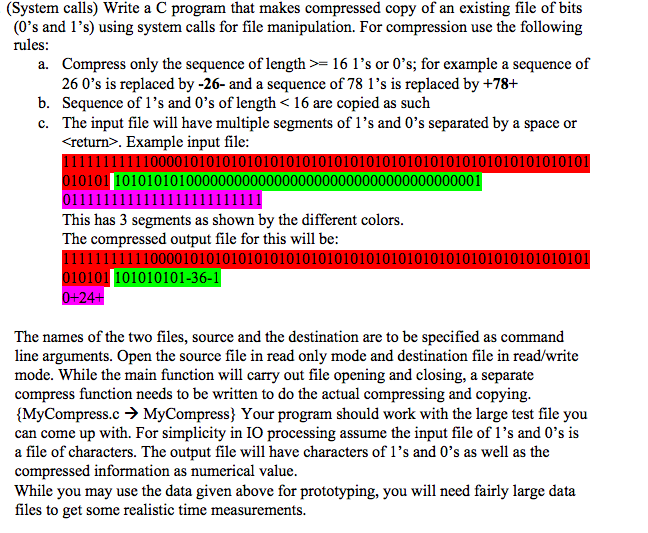Question
here is my code for #1. #include #include using namespace std; void myCompress(fstream &output, char lastRead, int sameNumOfChara) { if (lastRead == '0') { output

here is my code for #1.
#include
void myCompress(fstream &output, char lastRead, int sameNumOfChara) { if (lastRead == '0') {
output
int main() { fstream input; fstream output; input.open("input.txt"); output.open("output.txt");
char chara; char current; char lastRead = ' '; int sameNumOfChara = 0;
while (input.get(chara)) {
current = chara;
if (current != lastRead) {
if (sameNumOfChara >= 16) { myCompress(output, lastRead, sameNumOfChara); } else { for (int i = 0; i
if (sameNumOfChara >= 16) {
myCompress(output, lastRead, sameNumOfChara); }
else {
for (int i = 0; i
}
Need to create a concurrent version of it
This is the question of #1

Thanks in advance, need help :(
(concurrency) Write a concurrent version of the compression described above in problem #1. Create very large file, divide the file into equal chunks (say n) and allocate the work to n processes forked. Then assemble the result of each process and output it. You will have an input data file and output compressed data file. (ParFork.cParFork) (System calls) Write a C program that makes compressed copy of an existing file of bits (O's and 1's) using system calls for file manipulation. For compression use the following rules: a. Compress only the sequence of length >= 16 l's or 0's; for example a sequence of 26 0's is replaced by -26- and a sequence of 78 l's is replaced by +78+ b. Sequence of l's and 0's of length . Example input file: 110000101010101010101010101010101010101010101010101010101 0101011010101010000000000000000000000000000000000001 0111111111111111111111111 This has 3 segments as shown by the different colors. The compressed output file for this will be: 111111111110000101010101010101010101010101010101010101010101010101 010101 101010101-36-1 0+24+ The names of the two files, source and the destination are to be specified as command line arguments. Open the source file in read only mode and destination file in read/write mode. While the main function will carry out file opening and closing, a separate compress function needs to be written to do the actual compressing and copying. {MyCompress.c MyCompress} Your program should work with the large test file you can come up with. For simplicity in 10 processing assume the input file of l's and 0's is a file of characters. The output file will have characters of l's and 0's as well as the compressed information as numerical value. While you may use the data given above for prototyping, you will need fairly large data files to get some realistic time measurements. (concurrency) Write a concurrent version of the compression described above in problem #1. Create very large file, divide the file into equal chunks (say n) and allocate the work to n processes forked. Then assemble the result of each process and output it. You will have an input data file and output compressed data file. (ParFork.cParFork) (System calls) Write a C program that makes compressed copy of an existing file of bits (O's and 1's) using system calls for file manipulation. For compression use the following rules: a. Compress only the sequence of length >= 16 l's or 0's; for example a sequence of 26 0's is replaced by -26- and a sequence of 78 l's is replaced by +78+ b. Sequence of l's and 0's of length . Example input file: 110000101010101010101010101010101010101010101010101010101 0101011010101010000000000000000000000000000000000001 0111111111111111111111111 This has 3 segments as shown by the different colors. The compressed output file for this will be: 111111111110000101010101010101010101010101010101010101010101010101 010101 101010101-36-1 0+24+ The names of the two files, source and the destination are to be specified as command line arguments. Open the source file in read only mode and destination file in read/write mode. While the main function will carry out file opening and closing, a separate compress function needs to be written to do the actual compressing and copying. {MyCompress.c MyCompress} Your program should work with the large test file you can come up with. For simplicity in 10 processing assume the input file of l's and 0's is a file of characters. The output file will have characters of l's and 0's as well as the compressed information as numerical value. While you may use the data given above for prototyping, you will need fairly large data files to get some realistic time measurementsStep by Step Solution
There are 3 Steps involved in it
Step: 1

Get Instant Access to Expert-Tailored Solutions
See step-by-step solutions with expert insights and AI powered tools for academic success
Step: 2

Step: 3

Ace Your Homework with AI
Get the answers you need in no time with our AI-driven, step-by-step assistance
Get Started


